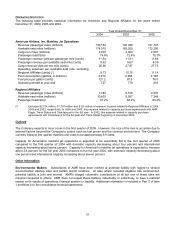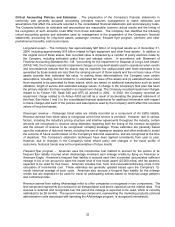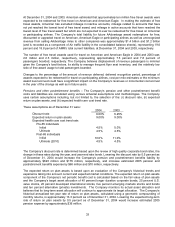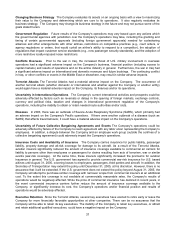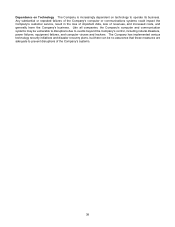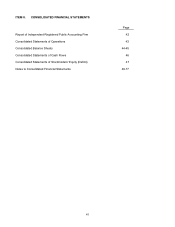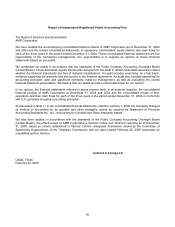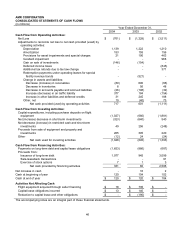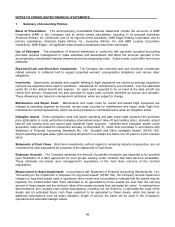American Airlines 2004 Annual Report Download - page 42
Download and view the complete annual report
Please find page 42 of the 2004 American Airlines annual report below. You can navigate through the pages in the report by either clicking on the pages listed below, or by using the keyword search tool below to find specific information within the annual report.
39
ITEM 7(A). QUANTITATIVE AND QUALITATIVE DISCLOSURES ABOUT MARKET RISK
Market Risk Sensitive Instruments and Positions
The risk inherent in the Company’s market risk sensitive instruments and positions is the potential loss arising
from adverse changes in the price of fuel, foreign currency exchange rates and interest rates as discussed below.
The sensitivity analyses presented do not consider the effects that such adverse changes may have on overall
economic activity, nor do they consider additional actions management may take to mitigate the Company’s
exposure to such changes. Therefore, actual results may differ. The Company does not hold or issue derivative
financial instruments for trading purposes. See Note 7 to the consolidated financial statements for accounting
policies and additional information.
Aircraft Fuel The Company’s earnings are affected by changes in the price and availability of aircraft fuel. In
order to provide a measure of control over price and supply, the Company trades and ships fuel and maintains fuel
storage facilities to support its flight operations. The Company also manages the price risk of fuel costs primarily
by using jet fuel, heating oil, and crude oil hedging contracts. Market risk is estimated as a hypothetical 10 percent
increase in the December 31, 2004 and 2003 cost per gallon of fuel. Based on projected 2005 fuel usage, such an
increase would result in an increase to aircraft fuel expense of approximately $377 million in 2005, inclusive of the
impact of fuel hedge instruments outstanding at December 31, 2004, and assumes the Company’s fuel hedging
program remains effective under Statement of Financial Accounting Standards No. 133, “Accounting for Derivative
Instruments and Hedging Activities”. Comparatively, based on projected 2004 fuel usage, such an increase would
have resulted in an increase to aircraft fuel expense of approximately $268 million in 2004, inclusive of the impact
of fuel hedge instruments outstanding at December 31, 2003. The change in market risk is due to the increase in
fuel prices and a decrease in the amount of fuel hedged. As of December 31, 2004, the Company had hedged,
with option contracts, approximately five percent of its estimated 2005 fuel requirements, or approximately 15
percent of its estimated first quarter 2005 fuel requirements, and a minimal amount of its estimated fuel
requirements thereafter. Comparatively, as of December 31, 2003 the Company had hedged, with option
contracts, approximately 21 percent of its estimated first quarter 2004 fuel requirements, 16 percent of its second
quarter 2004 estimated fuel requirements and six percent of its estimated fuel requirements for the remainder of
2004. A deterioration of the Company’s liquidity position could negatively affect the Company’s ability to hedge fuel
in the future.
Foreign Currency The Company is exposed to the effect of foreign exchange rate fluctuations on the U.S. dollar
value of foreign currency-denominated operating revenues and expenses. The Company’s largest exposure
comes from the British pound, Euro, Canadian dollar, Japanese yen and various Latin American currencies. The
Company does not currently have a foreign currency hedge program related to its foreign currency-denominated
ticket sales. The result of a uniform 10 percent strengthening in the value of the U.S. dollar from December 31,
2004 and 2003 levels relative to each of the currencies in which the Company has foreign currency exposure
would result in a decrease in operating income of approximately $93 million and $77 million for the years ending
December 31, 2005 and 2004, respectively, due to the Company’s foreign-denominated revenues exceeding its
foreign-denominated expenses. This sensitivity analysis was prepared based upon projected 2005 and 2004
foreign currency-denominated revenues and expenses as of December 31, 2004 and 2003, respectively.
Interest The Company’s earnings are also affected by changes in interest rates due to the impact those changes
have on its interest income from cash and short-term investments, and its interest expense from variable-rate debt
instruments. The Company’s largest exposure with respect to variable-rate debt comes from changes in the
London Interbank Offered Rate (LIBOR). The Company had variable-rate debt instruments representing
approximately 34 percent and 37 percent of its total long-term debt at December 31, 2004 and 2003, respectively.
If the Company’s interest rates average 10 percent more in 2005 than they did at December 31, 2004, the
Company’s interest expense would increase by approximately $21 million and interest income from cash and
short-term investments would increase by approximately $7 million. In comparison, at December 31, 2003, the
Company estimated that if interest rates averaged 10 percent more in 2004 than they did at December 31, 2003,
the Company’s interest expense would have increased by approximately $13 million and interest income from
cash and short-term investments would have increased by approximately $4 million. These amounts are
determined by considering the impact of the hypothetical interest rates on the Company’s variable-rate long-term
debt and cash and short-term investment balances at December 31, 2004 and 2003.




